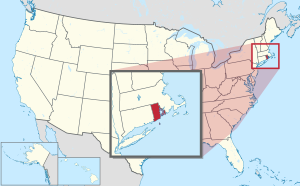
Back Rhode Island Afrikaans Rhode Island ALS ሮድ አይላንድ Amharic Rhode Island AN Rhode Īeg ANG رود آيلاند Arabic ܪܘܕ ܐܝܠܐܢܕ ARC رود آيلند ARY رود ايلاند ARZ Rhode Island AST
Rhode Island | |
|---|---|
| State of Rhode Island | |
| Nickname(s): The Ocean State Little Rhody[1] | |
| Motto: Hope | |
| Anthem: "Rhode Island's It for Me" | |
 Map of the United States with Rhode Island highlighted | |
| Country | United States |
| Before statehood | Colony of Rhode Island and Providence Plantations |
| Admitted to the Union | May 29, 1790 (13th) |
| Capital (and largest city) | Providence |
| Largest county or equivalent | Providence |
| Largest metro and urban areas | Greater Boston (combined) Providence (metro and urban) |
| Government | |
| • Governor | Dan McKee (D) |
| • Lieutenant governor | Sabina Matos (D) |
| Legislature | Rhode Island General Assembly |
| • Upper house | Senate |
| • Lower house | House of Representatives |
| Judiciary | Rhode Island Supreme Court |
| U.S. senators | Jack Reed (D) Sheldon Whitehouse (D) |
| U.S. House delegation | 1: Gabe Amo (D) 2: Seth Magaziner (D) (list) |
| Area | |
• Total | 1,545 sq mi (4,001 km2) |
| • Land | 1,034 sq mi (2,678 km2) |
| • Water | 511 sq mi (1,324 km2) 33.1% |
| • Rank | 50th |
| Dimensions | |
| • Length | 48 mi (77 km) |
| • Width | 37 mi (60 km) |
| Elevation | 200 ft (60 m) |
| Highest elevation | 812 ft (247 m) |
| Lowest elevation (Atlantic Ocean[3]) | 0 ft (0 m) |
| Population (2020 Census Results) | |
• Total | 1,098,163[4] |
| • Rank | 45th |
| • Density | 1,006/sq mi (388/km2) |
| • Rank | 2nd |
| • Median household income | $63,870[5] |
| • Income rank | 15th |
| Demonym | Rhode Islander |
| Language | |
| • Official language | De jure: None De facto: English |
| Time zone | UTC−05:00 (Eastern) |
| • Summer (DST) | UTC−04:00 (EDT) |
| USPS abbreviation | RI |
| ISO 3166 code | US-RI |
| Traditional abbreviation | R.I. |
| Latitude | 41° 09′ N to 42° 01′ N |
| Longitude | 71° 07′ W to 71° 54′ W |
| Website | ri |
Rhode Island (/ˌroʊd-/ , pronounced "road")[6][7] is a state in the New England region of the Northeastern United States. It borders Connecticut to its west; Massachusetts to its north and east; and the Atlantic Ocean to its south via Rhode Island Sound and Block Island Sound; and shares a small maritime border with New York, east of Long Island.[8] Rhode Island is the smallest U.S. state by area and the seventh-least populous, with slightly fewer than 1.1 million residents as of 2020;[9] but it has grown at every decennial count since 1790 and is the second-most densely populated state, after New Jersey. The state takes its name from the eponymous island, though nearly all its land area is on the mainland. Providence is its capital and most populous city.
Native Americans lived around Narragansett Bay before English settlers began arriving in the early 17th century.[10] Rhode Island was unique among the Thirteen British Colonies in having been founded by a refugee, Roger Williams, who fled religious persecution in the Massachusetts Bay Colony to establish a haven for religious liberty. He founded Providence in 1636 on land purchased from local tribes, creating the first settlement in North America with an explicitly secular government.[10] The Colony of Rhode Island and Providence Plantations subsequently became a destination for religious and political dissenters and social outcasts, earning it the moniker "Rogue's Island".[11]
Rhode Island was the first colony to call for a Continental Congress, in 1774, and the first to renounce its allegiance to the British Crown, on May 4, 1776.[12] After the American Revolution, during which it was heavily occupied and contested, Rhode Island became the fourth state to ratify the Articles of Confederation, on February 9, 1778.[13] Because its citizens favored a weaker central government, it boycotted the 1787 convention that had drafted the United States Constitution,[14] which it initially refused to ratify;[15] it finally ratified it on May 29, 1790, the last of the original 13 states to do so.[16][17]
The state was officially named the State of Rhode Island and Providence Plantations since the colonial era but came to be commonly known as "Rhode Island". On November 3, 2020, the state's voters approved an amendment to the state constitution formally dropping "and Providence Plantations" from its full name.[18] Its official nickname is the "Ocean State", a reference to its 400 mi (640 km) of coastline and the large bays and inlets that make up about 14% of its area.[19]
- ^ "Rhode Island Government: Government". RI.gov. Archived from the original on July 1, 2010. Retrieved July 31, 2010.
- ^ "State Area Measurements and Internal Point Coordinates".
- ^ a b "Elevations and Distances in the United States". United States Geological Survey. 2001. Archived from the original on October 15, 2011. Retrieved October 24, 2011.
- ^ "2020 Census Apportionment Results". The United States Census Bureau. April 26, 2021. Archived from the original on April 26, 2021. Retrieved April 27, 2021.
- ^ "Median Annual Household Income". KFF. Archived from the original on December 20, 2016. Retrieved December 9, 2016.
- ^ Jones, Daniel (2003) [1917], Peter Roach; James Hartmann; Jane Setter (eds.), English Pronouncing Dictionary, Cambridge: Cambridge University Press, ISBN 978-3-12-539683-8
- ^ "Rhode Island". Merriam-Webster.com Dictionary. Merriam-Webster.
- ^ "RG 042/RG 042.03. Rhode Island-New York Boundary, 1942-1944". Secretary of State. Archived from the original on November 13, 2018. Retrieved November 13, 2018.
- ^ "Table 1. Apportionment Population and Number of Representatives by State: 2020 Census" (PDF). Census Bureau. April 26, 2021. Archived (PDF) from the original on April 26, 2021. Retrieved April 26, 2021.
- ^ a b Lemons, J. Stanley. "Rhode Island | Map, Population, History, Beaches, & Facts". Britannica. Archived from the original on January 27, 2018. Retrieved November 10, 2021.
- ^ "Rhode Island – History". Britannica. Archived from the original on November 11, 2021. Retrieved November 11, 2021.
- ^ "The May 4, 1776, Act of Renunciation". Secretary of State of Rhode Island. Archived from the original on September 5, 2015. Retrieved May 3, 2014.
- ^ Jensen, Merrill (1959). The Articles of Confederation: An Interpretation of the Social-Constitutional History of the American Revolution, 1774–1781. University of Wisconsin Press. pp. xi, 184. ISBN 978-0-299-00204-6.
- ^ "Letter from Certain Citizens of Rhode Island to the Federal Convention". Ashland, Ohio: Teaching American History. May 11, 1787. Archived from the original on September 15, 2018. Retrieved October 21, 2015.
- ^ Flexner, James Thomas (1984). Washington, The Indispensable Man. New York: Signet. p. 208. ISBN 978-0-451-12890-4.
- ^ Vile, John R. (2005). The Constitutional Convention of 1787: A Comprehensive Encyclopedia of America's Founding (Volume 1: A-M). ABC-CLIO. p. 658. ISBN 978-1-85109-669-5. Archived from the original on February 1, 2016. Retrieved October 21, 2015.
- ^ "Rhode Island's Ratification". The U.S. Constitution Online. January 8, 2010. Archived from the original on September 6, 2018. Retrieved January 26, 2013.
- ^ Shamsian, Jacob (November 4, 2020). "Rhode Islanders voted to strip the word 'plantations' from their official state name". Business Insider. Archived from the original on November 4, 2020. Retrieved November 4, 2020.
- ^ Cite error: The named reference
areawas invoked but never defined (see the help page).
Cite error: There are <ref group=lower-alpha> tags or {{efn}} templates on this page, but the references will not show without a {{reflist|group=lower-alpha}} template or {{notelist}} template (see the help page).

